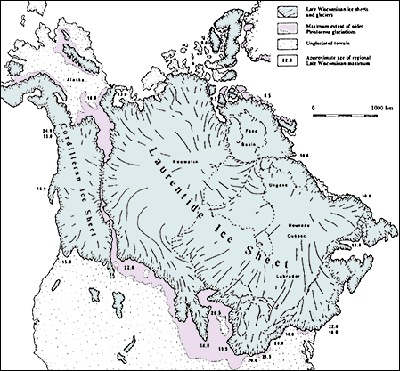
Lydia Kifner, MS Researcher, University of Maine; Department of Civil and Environmental Engineering
What makes a vernal pool form in the landscape? Like any other landscape feature, geologic history is a very important factor in understanding a vernal pool’s origins.
In the northeast, glaciers and glacial retreat comprise a large portion of recent geologic history. During the Pleistocene, North America was largely covered by glacial ice sheets. Over 10,000 years ago, ice sheets retreated from the northeastern North America landscape, and left chunks of ice buried in the surface. When those chunks of ice melted, the sand, mud, or gravel above them collapsed and formed “kettle holes”. Some of these kettle holes are small, shallow, circular depressions in the landscape that in present day can hold water for a period of the year and support a vernal pool ecosystem. In glacial outwash deposits composed of well-sorted sand and gravel and numerous kettle holes, there can be high densities of vernal pools.

Emerald Pond, a vernal pool located in a gravel esker, which is a type of deposit from retreating glaciers.
Glaciers can also scour the landscape and create depressions in the bedrock, and when these small basins collect water they can function as vernal pools. Depressions in the landscape can also form from melting glaciers, local erosion, or landslides. Indentations in the surface comprised of low-permeability material can form perched pools that have little to no drainage to the groundwater. Examples of these low permeable materials in the northeast include glacial till, glacial moraine deposits, and fine-grained glacial lake deposits.
Other ways that vernal pools form can be in river floodplains, where depressions can form during high water, and then hold water even when the stream has returned to normal flow conditions. Additionally, old meanders in the stream that have been cut off can continue to hold water and support vernal pool communities. Human activities can, in some cases, provide vernal pool habitat. Man-made ponds, detention basins, or quarries can sometimes support one or more vernal pool species.
Of course, the formation of a vernal pool is ultimately dependent on hydrology, because water is the most important factor in determining if a depression is simply a landscape feature, a temporary wetland, or a permanent water body. Some pools are precipitation and surface water flow-fed only, while others have influence from groundwater. Vernal pool biota are adapted to pools with temporary hydroperiods, and so the duration that these depressions hold water is very important. The duration of inundation is determined by the source of the water, as well as the permeability of the underlying geology.
References
Colburn EA (2004) Vernal pools: Natural history and conservation. McDonald & Woodward Publishing Company, Saline
